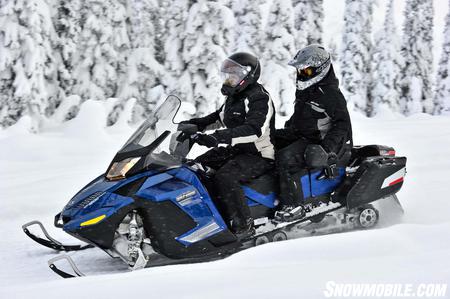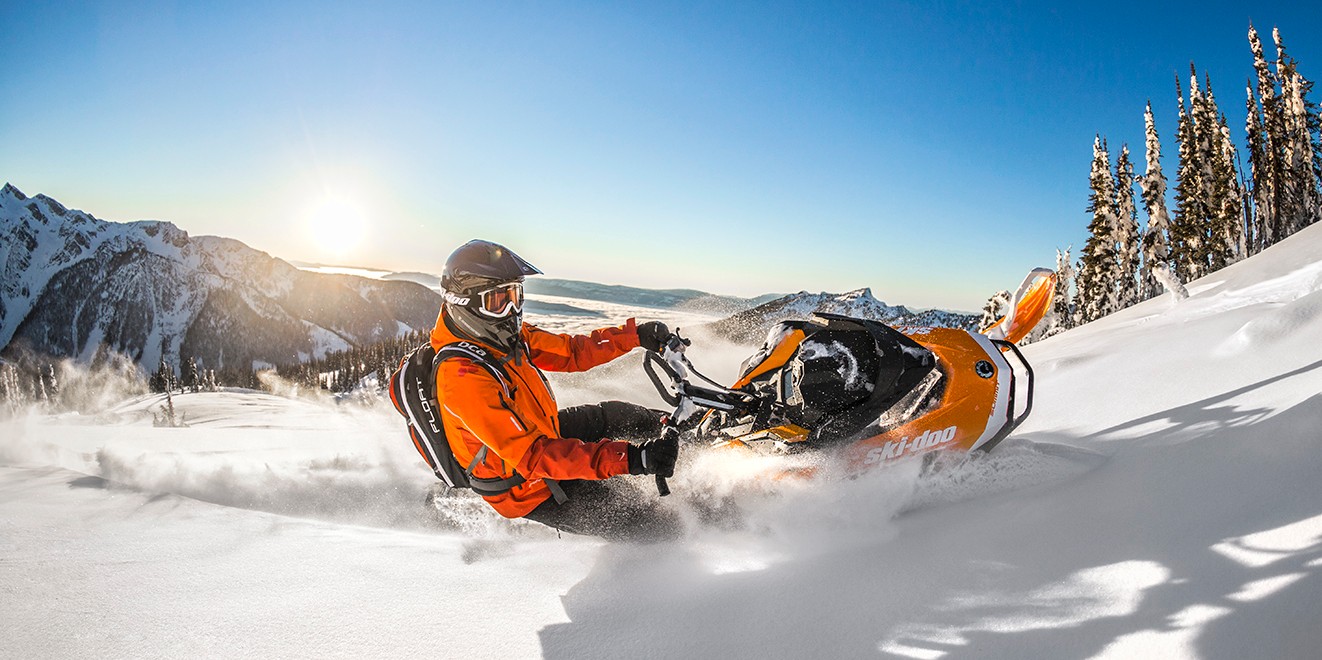 Just like most
sport vehicles, and unlike automobiles, snowmachines are
controlled mostly by the riders body. Sure you can
techincally just sit still and turn the handlebars, but this
only works at low speeds and in ideal conditions, and if you
attempt to ride this way at faster speeds or in deep snow
you will soon find yourself stuck or wrecked. As previously
mentioned, the chassis of the snowmachine is normally
oriented to accommodate the technique of the specific type
of riding that particular snowmachine is designed for. A
snowmachine designed for racing and trail riding will
typically have a lower seat and handlebars so that the
riders weight will be kept low to decrease wind resistance
and keep the snwomachine firmly on two skis for better
response in the turns. In deeper snow, where carving is
essential for turning, you want a higher seat and handlebars
to make it easier to transition between sitting and standing
and also provide you with the range of lateral motion
necessary to shift your weight and control the machine. Lets
discuss the different riding techniques for different types
of snowmachines.
Just like most
sport vehicles, and unlike automobiles, snowmachines are
controlled mostly by the riders body. Sure you can
techincally just sit still and turn the handlebars, but this
only works at low speeds and in ideal conditions, and if you
attempt to ride this way at faster speeds or in deep snow
you will soon find yourself stuck or wrecked. As previously
mentioned, the chassis of the snowmachine is normally
oriented to accommodate the technique of the specific type
of riding that particular snowmachine is designed for. A
snowmachine designed for racing and trail riding will
typically have a lower seat and handlebars so that the
riders weight will be kept low to decrease wind resistance
and keep the snwomachine firmly on two skis for better
response in the turns. In deeper snow, where carving is
essential for turning, you want a higher seat and handlebars
to make it easier to transition between sitting and standing
and also provide you with the range of lateral motion
necessary to shift your weight and control the machine. Lets
discuss the different riding techniques for different types
of snowmachines.Touring:
 Touring snowmachines are designed for luxury and
convenience. They are used primarily on well-established
trails at lower speeds and often have multiple seats and
towing capabilities for work or for winter family picnics.
Because touring snowmachines are so heavy and are designed
for luxury over sporting capability, they are easy to ride
in a comfortable sitting position and controlled primarily
by the handlebars. If you do decide to cut loose and have a
bit of fun at higher speeds, you may want to employ the more
aggressive cornering techniques of trail/racing
snowmachines.
Touring snowmachines are designed for luxury and
convenience. They are used primarily on well-established
trails at lower speeds and often have multiple seats and
towing capabilities for work or for winter family picnics.
Because touring snowmachines are so heavy and are designed
for luxury over sporting capability, they are easy to ride
in a comfortable sitting position and controlled primarily
by the handlebars. If you do decide to cut loose and have a
bit of fun at higher speeds, you may want to employ the more
aggressive cornering techniques of trail/racing
snowmachines.Trail/Racing:
 Trail and racing
snowmachines are similar to touring machines, but are
designed for speed and performance over luxury and
practicality. They typically have a lighter chassis and
lower profile. When riding these at low speeds they can be
handled the same way as touring machines, but once you start
getting more aggressive you need to change your riding
style. At high speeds, keep your weight low, preferably
fully behind the windshield to minimize air resistance. When
cornering at high speeds, keep your weight low and lean into
the turn to keep as much weight over the inside ski as
possible and prevent tipping. Smoothly and gradually turn
the handlebars in the direction you want to turn. If you
turn too sharp or too quickly or fail to keep your weight
low and to the inside, you can easily loose control and flip
the snowmachine.
Trail and racing
snowmachines are similar to touring machines, but are
designed for speed and performance over luxury and
practicality. They typically have a lighter chassis and
lower profile. When riding these at low speeds they can be
handled the same way as touring machines, but once you start
getting more aggressive you need to change your riding
style. At high speeds, keep your weight low, preferably
fully behind the windshield to minimize air resistance. When
cornering at high speeds, keep your weight low and lean into
the turn to keep as much weight over the inside ski as
possible and prevent tipping. Smoothly and gradually turn
the handlebars in the direction you want to turn. If you
turn too sharp or too quickly or fail to keep your weight
low and to the inside, you can easily loose control and flip
the snowmachine. Mountain/Deep Powder:
 And now we come to my
personal favorite, the mountain machine. Mountain
snowmachines are the most lightweight and designed for
flotation and carving capability in deep snow. They are
designed with a higher chassis, wider skis, and a longer
track. When riding in deep powder, a standing position is
preferable to sitting. Regular turning techniques are
ineffective in deep snow, and carving technique must be
applied. From a standing position, lean in the direction you
want to turn and simultaneously turn the handlebars opposite
the direction you want to turn. The snowmachine will tip to
the inside of the turn but don't panic! This is the key
element of carving. The farther the snowmachine tips, the
tighter it will turn. Depending on the depth of the snow,
the magnitude of tipping can be controlled by how far you
turn the handlebars or by how far over you lean. It is not
uncommon for more advanced riders to put their outside knee
on the seat or even bring the outside leg to the inside of
the snowmachine altogether.
And now we come to my
personal favorite, the mountain machine. Mountain
snowmachines are the most lightweight and designed for
flotation and carving capability in deep snow. They are
designed with a higher chassis, wider skis, and a longer
track. When riding in deep powder, a standing position is
preferable to sitting. Regular turning techniques are
ineffective in deep snow, and carving technique must be
applied. From a standing position, lean in the direction you
want to turn and simultaneously turn the handlebars opposite
the direction you want to turn. The snowmachine will tip to
the inside of the turn but don't panic! This is the key
element of carving. The farther the snowmachine tips, the
tighter it will turn. Depending on the depth of the snow,
the magnitude of tipping can be controlled by how far you
turn the handlebars or by how far over you lean. It is not
uncommon for more advanced riders to put their outside knee
on the seat or even bring the outside leg to the inside of
the snowmachine altogether.